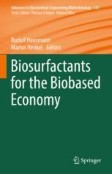Search
Search Results
-
Biochemistry and General Genetics of Nonribosomal Peptide Synthetases in Fungi
Peptides like penicillin or cyclosporin are nonribosomally synthesised by large multifunctional enzymes. Peptide synthetase genes are coexpressed...
-
Metagenomic domain substitution for the high-throughput modification of nonribosomal peptides
The modular nature of nonribosomal peptide biosynthesis has driven efforts to generate peptide analogs by substituting amino acid-specifying domains...

-
Saccharomyces cerevisiae as host for the recombinant production of polyketides and nonribosomal peptides
As a robust, fast growing and genetically tractable organism, the budding yeast Saccharomyces cerevisiae is one of the most widely used hosts in...

-
High-throughput reprogramming of an NRPS condensation domain
Engineered biosynthetic assembly lines could revolutionize the sustainable production of bioactive natural product analogs. Although yeast display is...

-
Nonribosomally and Ribosomally Synthesized Bioactive Peptides (NRPS and RiPPs) from Actinobacteria
From time immemorial, natural products (NPs) are a major source of drugs in the pharmaceutical industry ranging from antibiotics, anti-depressants,...
-
Transcriptomic and metabolomic analyses for providing insights into the influence of polylysine synthetase on the metabolism of Streptomyces albulus
ε-poly- l -lysine (ε-PL) is the main secondary metabolite of Streptomyces albulus , and it is widely used in the food industry. Polylysine synthetase...

-
The Antibacterial and Antibiofilm Activities of the Endophytic Bacteria Associated with Archidendron pauciflorum against Multidrug-Resistant Strains
Endophytes associated with medicinal plants are a potential source of valuable natural products. This study aimed to evaluate the antibacterial and...

-
Co-occurrence of enzyme domains guides the discovery of an oxazolone synthetase
Multidomain enzymes orchestrate two or more catalytic activities to carry out metabolic transformations with increased control and speed. Here, we...

-
Biosynthesis of Odd-Carbon Unsaturated Fatty Dicarboxylic Acids Through Engineering the HSAF Biosynthetic Gene in Lysobacter enzymogenes
Fatty dicarboxylic acids (FDCA) are useful as starting materials or components for plastics, polyesters, nylons, and fragrances. Most of the...

-
Draft genome sequence of Actinocorallia populi A251T, an actinomycetes producing polyketides and nonribosomal polypeptides
In this work, we present the draft genome sequence of Actinocorallia populi A251 T consisting of 8,253,402 bp with a G + C content of 71.5 mol%. The...

-
Mutagenetic analysis of the biosynthetic pathway of tetramate bripiodionen bearing 3-(2H-pyran-2-ylidene)pyrrolidine-2,4-dione skeleton
BackgroundNatural tetramates are a family of hybrid polyketides bearing tetramic acid (pyrrolidine-2,4-dione) moiety exhibiting a broad range of...

-
Cryptic enzymatic assembly of peptides armed with β-lactone warheads
Nature has evolved biosynthetic pathways to molecules possessing reactive warheads that inspired the development of many therapeutic agents,...

-
Structural basis of keto acid utilization in nonribosomal depsipeptide synthesis
Nonribosomal depsipeptides are natural products composed of amino and hydroxy acid residues. The hydroxy acid residues often derive from α-keto...

-

-
Repurposing degradation pathways for modular metabolite biosynthesis in nematodes
Recent studies have revealed that Caenorhabditis elegans and other nematodes repurpose products from biochemical degradation pathways for the...

-
Mining and characterization of the PKS–NRPS hybrid for epicoccamide A: a mannosylated tetramate derivative from Epicoccum sp. CPCC 400996
BackgroundGenomic analysis indicated that the genomes of ascomycetes might carry dozens of biosynthetic gene clusters (BGCs), yet many clusters have...

-
Bacillus sp.: A Remarkable Source of Bioactive Lipopeptides
Surfactin, one of the best lipopeptide surfactants, was first isolated from Bacillus sp. in 1969. Since then, Bacillus sp. has been a remarkable...
-

-
Engineering Heterologous Hosts for the Enhanced Production of Non-ribosomal Peptides
Non-ribosomal peptides (NRPs) are a family of secondary metabolites with the highest number among entire secondary metabolite types. They are...
-
Chemoenzymatic approaches for exploring structure–activity relationship studies of bioactive natural products
Spurred by advancements in microbial genetics and enzyme engineering, chemoenzymatic strategies, which combine enzymatic and synthetic...

